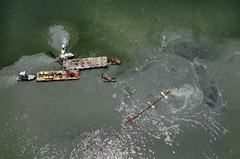Sand berms a dubious solution to Gulf oil spill
By Len Bahr, Contributing Op-Ed columnist, www.LaCoastPost.com
Published: Monday, July 05, 2010, 6:00 PM The coast of Louisiana occupies North America’s largest delta, which has been rapidly shrinking and sinking for a century. River channelization, flood levees, upriver dams and coastal oil and gas production continue to take their toll. But a decade from now, the unprecedented discharge of perhaps 100,000 barrels a day of oil directly off our coast for months on end may prove to have been as damaging to the delta as these historic stressors. Obviously no handbook exists on effective responses to such a massive oil release. This policy vacuum, combined with panic and desperation among coastal residents, created an irresistible opportunity for grandstanding on the part of our ambitious young governor. In this highly charged political climate it is not surprising that Bobby Jindal would opt for responses to the oil crisis based more on drama than effectiveness. For example, he would likely prefer to be videotaped in front of a massive, noisy dredge boat stirring up mud than observing small craft silently skimming the water surface. Thus, the governor’s most widely discussed response to the coastal oil assault is to pile up defensive sand barriers. The rationale for this action is to intercept the oil before it can contaminate the wetlands that hold delta sediments in place, nourish fish and wildlife and protect people from storms. About 80 miles of 6-foot-high sand berms are now under construction on the lower east and west sides of the Mississippi River. The total quantity of sand required to complete this project is said to be 56 million cubic yards — the equivalent of 11.2 times the volume of the Superdome! Some of this (sacrificial) sand is being dredged from the lower river channel, but most is being mined from old barrier islands that have sunk beneath the sea. Although the dredging doesn’t leave a visible change at the surface, it alters the subsurface profile of an area and reduces the bottom friction that formerly absorbed hydraulic energy during approaching storm surges. On the basis of 22 years of academic training and experience in coastal science and 18 years of policy experience in the Governor’s Office of Coastal Activities, I’m strongly opposed to the governor’s sand berm project for the following nine reasons: …
